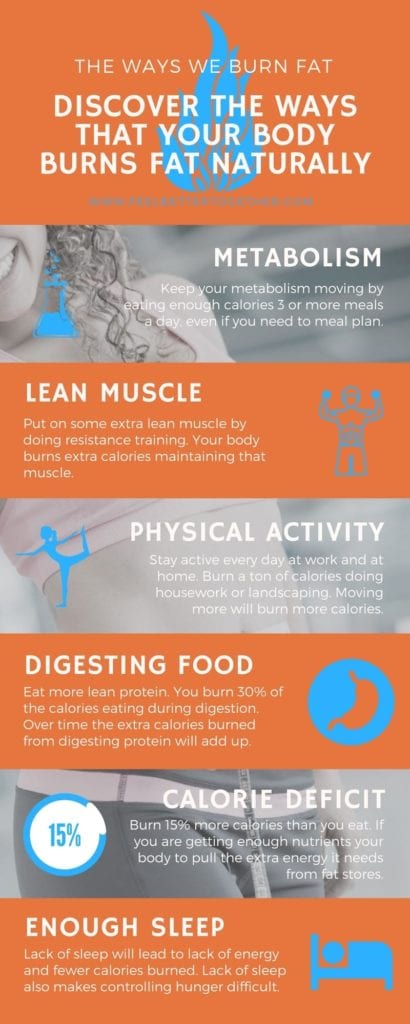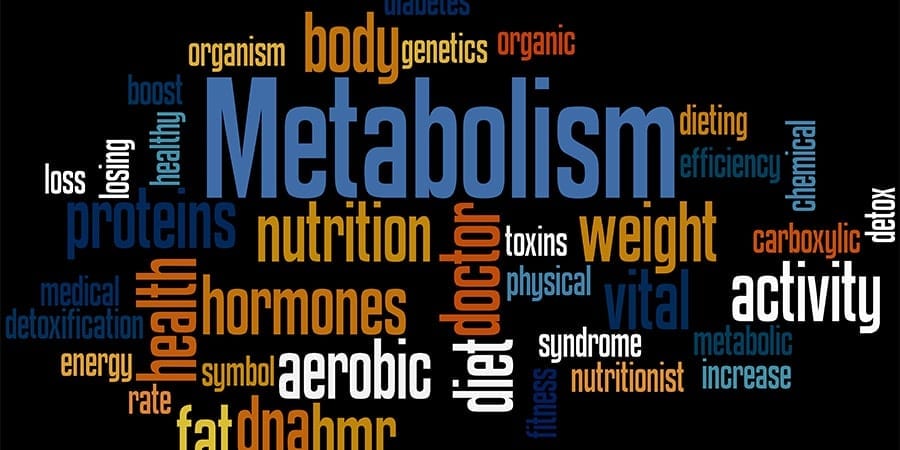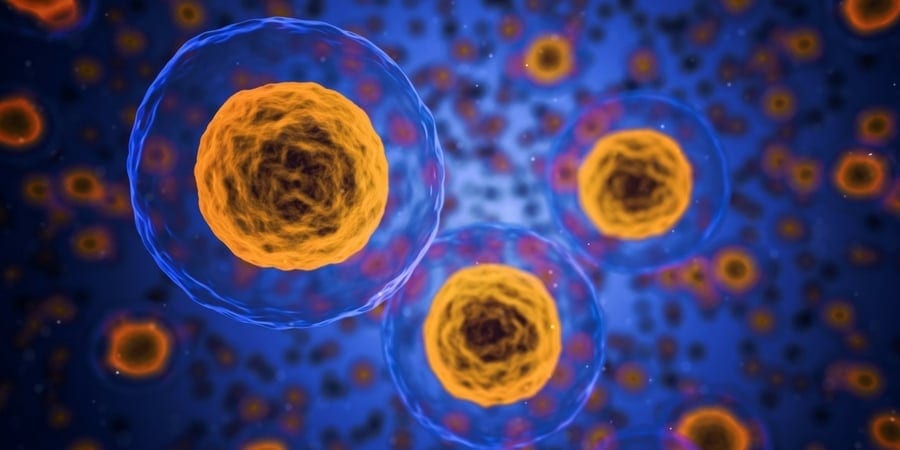Did you know your body burns fat by design? Your body thinks fat is good! It’s using fat right now for moisture, absorbing vitamins, warmth, and cellular energy. Your body needs fat. You might find it hard to believe, not getting enough fat is malnutrition.
There’s a whole system in place called your metabolism. One of its jobs is to break down food so it can use it for energy or store it in fat cells. It’s good at its job, and that being the case, it can save too much body fat, which is dangerous for your health.
The problem is your body doesn’t seem to care what you think about extra body fat. It doesn’t take regard for whether it’s dangerous down the road.
But, you can discover the different ways your body burns calories. You can learn how to melt belly fat fast naturally and reach your fat loss goals, restoring your body fat to a healthy level.
Five Easy Ways to Melt Even Belly Fat Fast and Naturally
- Keep your metabolism moving, by eating enough calories. 3 or more meals a day, even if you need to meal plan.
- Put on some extra lean muscle by doing resistance training. Your body burns extra calories maintaining that muscle.
- Stay active every day while at work and at home. Burn a ton of calories doing housework or landscaping. Moving more will burn more calories.
- Eat more lean protein. You burn 30% of the calories during digestion. Over time the extra calories burned from digesting protein will add up.
- Burn 15% more calories than you eat. If you’re getting enough nutrients your body to pull the extra energy it needs from fat stores.
BONUS TIP! Get proper sleep so that you don’t sabotage your fat loss goals. Lack of sleep will lead to lack of energy and fewer calories burned. Lack of sleep also makes controlling hunger difficult.

What Does Metabolism Mean? – Supply and Demand
Your metabolism plays a role in many vital jobs around your body. Your body wants to break down whatever it can get a hold of, into it’s smallest usable form. Once your body breaks things down, it can do a lot of stuff with these base chemicals.

So what does metabolism mean? The dictionary says it’s a chemical process that occurs to maintain life. The whole process comes down to supply and demand.
Once inside your body, food breaks down, and this process releases energy. Scientists call this energy adenosine triphosphate (ATP). Your cells use ATP to transport nutrients and make changes. Your body uses this power to put together the building blocks for new essential cells.
In metabolic terms, ‘catabolism’ is supply. It is how your body obtains (or supplies) available materials to maintain itself. ‘Anabolism’ is the demand, because that is when your body uses those materials. Let’s take a look at each of them.
Catabolism – Where Energy Comes From
Your body is a needy machine and will break down whatever it can metabolize, looking for whatever it can use. Your body breaks things down several times, obtaining something useful at each step.
This process of gathering fuel and materials involves several parts of your body. Your metabolism looks for what it can use in your digestive tract and lungs, as well as on your skin. Everything left over that your body is not able to use passes in your waste or sweat.
If your body can’t meet fuel and physical demands from external sources, it begins to look for what it has stored. Your body has more stored than you’d think.
There are reserves of fuel and materials in your fat cells and muscle tissue. Your metabolism will break them down in the case of a calorie shortage.
Anabolism – Where Energy Goes
Your body mobilizes resources in an efficient way to maintain itself. It needs a lot of fuel and materials. Your body is always feeding, duplicating, and replacing trillions of cells.
There is wear and tear that comes with life on planet earth, and your body is continually healing as a result.
Your cells look for easy to use fuel and materials, in your blood. That’s where most useful materials end up after they are broken down. Running low on these valuable elements for extended periods of time is referred to as malnutrition. Running out of these is starvation.
Having enough fuel in the tank is important, even more so for teenagers. They are no longer small children but still growing new cells and tissue. It’s essential that they get enough calories to maintain their growth.
It’s not only teenagers developing a lot of new cells and tissue. Extreme athletes and bodybuilders know anabolism well. These athletes are always using a lot of energy and putting stress on their bodies.
Your metabolism goes to great lengths to keep you alive. It is responsive and responsible for making sure supply and demand match up. It’s about survival. Keeping your metabolism in check will maximize energy levels as well as fat loss.
Basal Metabolic Rate – Resting is Hard Work
Resting is one of the most fabulous ways to burn calories. In fact, you are doing it right now. You don’t even have to try! Your body needs calories to maintain itself.

Doctors call the number of calories your burns to sustain itself for 24 hours your basal metabolic rate, or BMR. It turns out that your body needs a whole lot of calories to maintain itself.
Most of Your Calories
Your BMR represents about 70% of the total calories you use up in a day. Someone who burns an average of 2,000 calories per day, would burn 1,400 calories if they ate nothing and did not move. These calories get used up maintaining your lean muscle. More calories go to things like pumping your heart, breathing, swallowing, and blinking.
Finding out your exact BMR can be difficult. The most accurate reading requires many medical tests. You would need to factor in diet, body composition, lean mass, and body temperature.
Using some simple math, you can find a reasonable estimate of your BMR. The Mifflin St Jeor Equation, which factors in body weight as a whole.
BMR Changes
You have little control over your BMR. As we age and lean muscle decreases, our BMR goes down. Most of the time you want the number of calories you burn each day to go up, not down.
Building lean muscle makes your BMR go up, and that causes you to burn more calories.
Building lean muscle is the only way you can increase our BMR, and it’s a small impact. But hey, when you’re on a mission to burn fat every last bit helps.
You don’t want your BMR to go down like if you are in a calorie deficit that’s too big, your body will lower its output. Burning fewer calories means you’ll be sabotaging your fat-burning efforts.
Burning Calories Walking – Fat Loss From Anywhere
The question almost everyone asks when they first start losing weight is “Can I get in shape without going to the gym?” I’ve asked it.
No one would complain if we could burn fat without ever stepping on a treadmill. The truth is, you can.

As long as you keep your calorie intake below your maintenance level, you will burn fat every day.
You burn calories doing housework, standing up at work, and walking around. When you use a muscle, your body starts to replace the energy stored in that tissue.
Everyday tasks often use several muscles, and over time this results in burning a lot of calories.
Everyday Activities Burn Calories
You might not think everyday activities use your muscles enough. But, anyone who landscapes property knows. You don’t even have to go that far, try putting on a shower curtain with the rod fixed into the wall.
Try working on a ceiling fixture that’s giving you trouble. Everyday tasks can burn a lot of calories.
About 20% of the calories you burn each day on average come from physical activity. That’s about 400 calories for a person who uses 2,000 calories each day.
Burning calories assuming you rarely sit and are staying active, even at home. So if you sit down a lot and you’d like to burn fat, eat to maintain and start moving a little.
Burning More Calories
Physical activity is the best way for you to create a gap between the calories you eat and the calories you burn. Exercise is much healthier than trying to eat less while staying sedentary.
Be careful not to cut calories to the point of malnutrition and lean muscle loss.
You have a lot of control over your lifestyle. You will burn more calories if you live an active lifestyle. You will burn even more calories if you go to the gym or exercise at home.
In short, you can move more to burn more fat and prevent muscle loss. Take the stairs instead of the elevator. Go for a walk for enjoyment. These are great ways to take calorie burn to the next level.
Turning Food Into Energy – It Takes Energy to Make Energy
p>Do you ever wonder where your body gets the power to turn food into more energy? It takes energy to make energy, and the stomach is only the first step.
The gastrointestinal tract or GI tract puts other essential organs to work. The small intestine, pancreas, as well as other systems in your body, assist cell nutrition.

All the extra work digesting food is about 10% of the calories you burn each day. Scientists call this the thermal effect of food. It’s pretty simple, but not all food requires the same energy to digest.
Your macronutrient balance can have an impact on burning fat.
Digesting Fats and Carbohydrates
Your body burns about 3% of the calories you get from fats during digestion. Lipids are the main thing your body uses when it breaks down fats.
Your colon is what breaks down fiber, all that it can. Your body burns about 10% of the calories you get from carbohydrates and breaks down most carbohydrates into glucose.
Digesting Protein
Our winner here is protein. You use up about 30% of the calories you get from protein during digestion. Amino acids are what your body needs when it breaks down protein.
Breaking down protein into amino acids requires a lot more work done by your stomach.
Strong bonds hold amino acids together. Stronger than the ones containing together glucose or lipids. We can use this information to increase our results and burn unwanted body fat.
There’s no such thing as a zero-calorie food because all food contains calories. There are foods with few calories that are high in protein and other nutrients. A low-calorie protein-rich diet like broccoli will help control hunger and fat burn.
Excellent Sources of Protein For Getting into the Fat Burn Zone
- Greek Yogurt
- Lean Turkey or Chicken
- Tuna
- Navy Beans
- Peanut Butter
Up to 50% of your total diet as protein is difficult to do, but over time will burn a little bit of extra body fat.
You can lose more fat over time by paying attention to your diet and how your body turns food into energy. Doing this is going to help you keep the calorie burn up and calorie intake in check, which leads to more fat burn.
How Many Calories in a Pound? – Burning a Pound of Fat for Energy
When you are on a mission to lose weight, each pound you lose is a small victory. Burning fat, in particular, is a little more complicated but is also much more rewarding. For most people, this is the real goal.
Your body has energy stored in muscle as well. Your body would much instead break down muscle tissue when it’s low in nutrients.
When your body doesn’t have what it needs, it focuses on decreasing output in an attempt to catch up. Breaking down muscle is a win-win for a malnourished body. Not only does caloric output decrease, but your cells also get some nutrients.

Long story short, eating too few calories causes muscle loss instead of fat loss. You need to train your body to look for energy in your fat cells, by getting enough nutrients in a calorie deficit.
Fat cells are about 85-90% fat, so burning an extra 4,000 calories would burn about 3,500 worth of stored body fat. 1 gram of protein or carbs provides about four calories, one gram of fat contains nine calories, and there are 453 grams in 1 pound.
Calorie Deficit
If you are eating the same amount of calories that you burn or more, your fat stores will not be going anywhere. Eating fewer calories might seem obvious, but there’s a catch.
Most people, at first, create a calorie deficit that’s massive. Or they’ll eat empty calories like refined grains and sugars. Either of these means you’re not getting enough calories or nutrients.
The quickest way to measure a healthy calorie deficit is by percentage. Eating 10-15% fewer calories than you burn is safe and comfortable for almost everyone. If you are active and eat nutrient-rich food, you will lose about half a pound per week on average.
Let’s say you burn 2,000 calories in a day right now, but only ate 1750 calories. Your body will pull the extra 250 calories it needs from fat stores.
There is hardly ever a need to attempt an aggressive calorie deficit like 25% for instance. These are not always practical and call for a lot of planning.
Only try an aggressive calorie deficit if you have a good understanding of your own body. You must make sure you get the nutrients you need to keep your body going.
Otherwise, you will end up with less muscle, more fat, and uncertainty about how to reach your goals.
Visceral Fat
Not all body fat is as straightforward to burn like the rest. When we accumulate large amounts of body fat, certain fat forms in places other than the skin. Visceral fat, which is harder for your body to break down, takes longer to burn.
Good job to you if you have lost a lot of unwanted body fat lately. One of the things you may be dealing with now is visceral fat, and you might not even be sure what to do about it.
Visceral fat is further beneath the skin, but it is often noticeable in your belly and waist.
Visceral fat releases toxins and can have some serious adverse health effects. To burn off visceral fat, you need to cover all your fat loss bases.
These bases include eating healthy, getting enough sleep, and exercising. The most important of these is eating right.
Trying to burn fat without exercising is slow and uncomfortable. Doing this usually causes muscle loss instead of fat loss. Burning visceral fat will be more of a struggle.
There is always the use of dangerous supplements to try losing weight. Or, you can check your calorie intake while burning calories with exercise, and light the fire. Your extra body fat will melt away.
In Conclusion
There are few things worse than having a weight problem and not knowing what to do about it. What is even worse is working hard to lose weight and not seeing any results.
You’ve been given this information so now use it. There’s no one stopping you but you!
Now spend some time thinking about your motivation to burn fat. Burning fat is natural for some people, and they have the opposite problem, it’s hard for them to put on weight.
Your body burns fat all on its own when the conditions are right. It’s the lifestyle change required to burn fat that is difficult.
You need your motivation to put in the work when things get hard.
Think of the great rewards at the end of your fat loss journey. To some, it’s a matter of seeing themselves differently, and to others, it’s a life or death situation.

